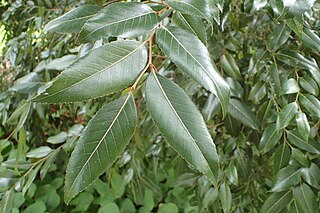
Nothofagus moorei, commonly known as Antarctic beech, is an important Gondwana relict of the rainforests of the southern hemisphere. It occurs in wet, fire-free areas at high altitude in eastern Australia.

Brachychiton acerifolius is a large tree of the family Malvaceae endemic to tropical and subtropical regions on the east coast of Australia. It is famous for the bright red bell-shaped flowers that often cover the whole tree when it is leafless. It is commonly known as the flame tree, Illawarra flame tree, lacebark tree, or kurrajong.

Tasmannia lanceolata, commonly known as pepper tree, native pepper, mountain pepper or mountain pepperbush, is a species of flowering plant in the family Winteraceae, and is endemic to south-eastern Australia. It is a dioecious bushy shrub to small tree with lance-shaped or narrowly ellipic leaves, male and female flowers on separate plants, the flowers with 3 to 9 petals, and the fruit a deep maroon to glossy black berry.

Commersonia is a genus of twenty-five species of flowering plants in the family Malvaceae. Plants in this genus are shrubs or trees, occurring from Indochina to Australia and have stems, leaves and flowers covered with star-like hairs. The leaves are simple, often with irregularly-toothed edges, the flowers bisexual with five sepals, five petals and five stamens and the fruit a capsule with five valves. The genus underwent a revision in 2011 and some species were separated from Commersonia, others were added from Rulingia.

Triunia is a genus of medium to tall shrubs or small trees found as understorey plants in rainforests of eastern Australia. Members of the plant family Proteaceae, they are notable for their poisonous fleshy fruits or drupes. Only one species, T. youngiana, is commonly seen in cultivation.

Tasmannia stipitata, commonly known as northern pepperbush is a flowering plant in the family Winteraceae and is endemic to eastern Australia. It has narrowly lance-shaped to narrowly elliptic leaves and male and female flowers on separate plants, the male flowers with 21 to 65 stamens and the female flowers with 2 to 9 carpels. The fruit is bluish-violet and contains 12 to 15 seeds.
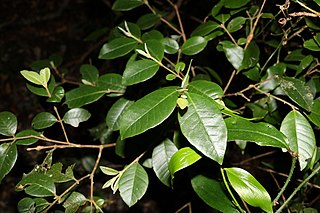
Lenwebbia is a genus of shrubs or small trees in the myrtle family Myrtaceae. The type species is Lenwebbia lasioclada.

Mischocarpus is a genus of about nineteen species of trees known to science, constituting part of the plant family Sapindaceae. They grow naturally from Australia and New Guinea, though Malesia as far north as the Philippines, through SE. Asia, Indo-China and S. China, to India at their farthest west. The eleven Australian species known to science grow naturally in the rainforests of the eastern coastal zone of New South Wales and Queensland, from Newcastle northwards through to north-eastern Queensland and Cape York Peninsula.

Gossia bidwillii, known as the python tree is a rainforest myrtle of eastern Australia. The usual habitat is the drier rainforest areas. The range of natural distribution is from the Hunter River in New South Wales to Coen in far northern Queensland.
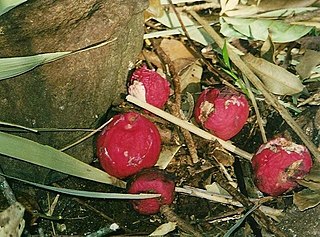
Syzygium ingens, commonly known as red apple, is a species of flowering plant that is endemic to eastern Australia. It is a medium-sized to tall rainforest tree with narrow elliptic to oblong leaves and panicles of white flowers on the ends of branchlets, followed by spherical red berries.
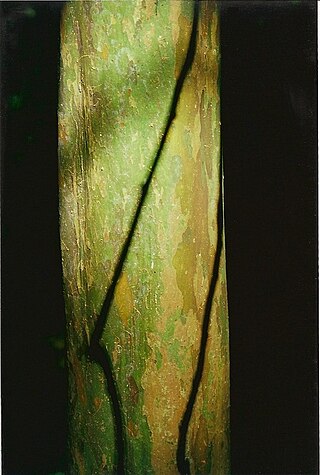
Gossia is a genus of rainforest trees in the myrtle family first described as a genus in 2003 by Neil Snow, Gordon Guymer and Sawvel. It is native to northeastern Australia as well as several islands of Papuasia and New Caledonia.
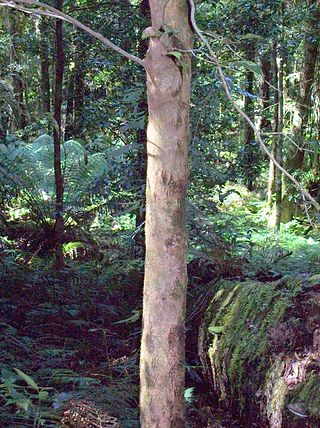
Gossia acmenoides, known as the scrub ironwood, is a rainforest tree of the family Myrtaceae, native to eastern Australia. The usual habitat of this small tree is drier rainforest areas. The range of natural distribution is from Jamberoo in New South Wales to Eungella National Park in northern Queensland.

Mischocarpus pyriformis, known as the pear fruited tamarind is a rainforest tree of eastern Australia. Occurring from Seal Rocks, New South Wales to as far north as Cooktown in tropical Queensland. The sub species found in New South Wales is Mischocarpus pyriformis subsp. pyriformis.
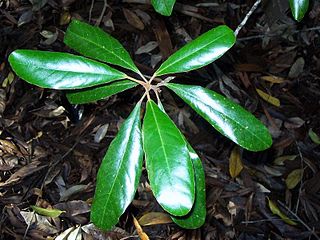
Elaeocarpus williamsianus, commonly known as hairy quandong, is a species of flowering plant in the family Elaeocarpaceae and is endemic to a restricted area of north-eastern New South Wales. It is a small tree with lance-shaped leaves, racemes of greenish-white flowers and spherical blue fruit.

Uromyrtus lamingtonensis is a rare Australian shrub growing around the state border of New South Wales and Queensland. Like the Peach Myrtle, it has attractive pink flowers.

Rhodamnia whiteana, known as the cliff malletwood or White's malletwood is a sub-tropical rainforest plant of eastern Australia. It was first formally described in 1986 by Gordon Guymer and Laurence Jessup from a specimen collected from Mount Cordeaux.
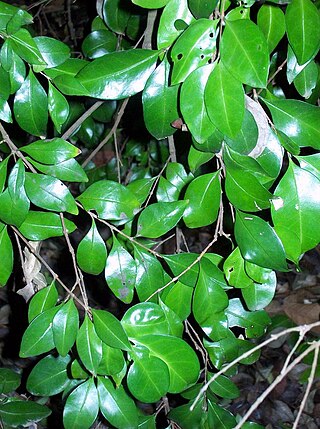
Gossia fragrantissima, the sweet myrtle or small-leaved myrtle, is a shrub or small tree of eastern Australia. A plant with a ROTAP rating of 3EC-, endangered by extinction.

Litsea australis, the brown bollygum or brown bollywood is a species of rainforest tree in the laurel family, found in eastern Australia. The specific epithet australis means "southern". As this southern population was considered to be Litsea leefeana, until reclassified by the rainforest botanist Bernie Hyland in 1989. This species is found in a variety of different rainforest types, but often seen growing near the sea. Distributed from Forster, New South Wales in the south to Fraser Island in Queensland.

Gossia gonoclada, known as the square-stemmed or angle-stemmed myrtle for the distinctive four raised corners on the angled branchlets, is a rainforest tree of the family Myrtaceae, native to south-east Queensland, Australia. It is an endangered species.

Mischocarpus lachnocarpus, the woolly brush apple, is a rainforest tree, mostly seen in tropical north eastern Queensland, Australia.



















